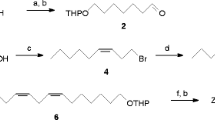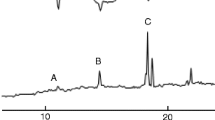Abstract
Biston robustum Butler, a polyphagous defoliator, multiplied on Hachijo-jima Island in 1997–1998. Based on GC-MS data of authentic standards, an analysis of a pheromone gland extract of the females indicated that it included (Z,Z)-6,9–nonadecadiene (I), (Z,Z,Z)-3,6,9–nonadecatriene (II), cis-(Z)-6,7–epoxy-9–nonadecene (III), and cis-(Z,Z)-6,7–epoxy-3,9–nonadecadiene (IV) in a ratio of 13 : 2 : 70 : 15. The structure of III was confirmed by a GC-MS analysis of another extract treated with dimethyl disulfide (DMDS). This epoxymonoene was successfully converted into the corresponding DMDS adduct that showed diagnostic ions fragmented at an epoxy ring and at thiomethoxy groups reflecting the position of an original double bond. Furthermore, the 6S,7R configuration was assigned for the epoxy ring of III by chiral HPLC analysis. Field examination of synthetic lures revealed that the two epoxy compounds (III and IV) with the 6S,7R configuration were essential components and that the two unsaturated hydrocarbons (I and II) showed a synergistic effect on male attraction.
Similar content being viewed by others
REFERENCES
Ando, T., Ohsawa, H., Ueno, T., Kishi, H., Okamura, Y., and Hashimoto, S. 1993. Hydrocarbons with a homoconjugated polyene system and their monoepoxy derivatives: Sex attractants of geometrid and noctuid moths distributed in Japan. J. Chem. Ecol. 19:787–798.
Ando, T., Kishi, H., Akashio, N., Qin, X.-R., Saito, N., Abe, H., and Hashimoto, S. 1995. Sex attractants of geometrid and noctuid moths: Chemical characterization and field test of monoepoxides of 6,9–dienes and related compounds. J. Chem. Ecol. 21:299–311.
Ando, T., Ohtani, K., Yamamoto, M., Miyamoto, T., Qin, X.-R., and Witjaksono. 1997. Sex pheromone of Japanese giant looper, Ascotis selenaria cretacea: Identification and field tests. J. Chem. Ecol. 23:2413–2423.
Arn, H., TÓth, M., and Priesner, E. 1992. List of Sex Pheromones of Lepidoptera and Related Attractants. OILB-SROP/IOBC-WPRS, Secrétariat Général, F-84143 Montfavet, France, ISBN 92–9067–044–4, 179 pp.
Arn, H., TÓth, M., and Priesner, E. 1997. List of sex pheromones of Lepidoptera and related attractants, supplement 1992–1996. Technol. Trans. Mating Disrupt. 20:257–293.
Buser, H.-R., Arn, H., Guerin, P., and Rauscher, S. 1983. Determination of double bond position in mono-unsaturated acetates by mass spectrometry of dimethyl disulfide adducts. Anal. Chem. 55:818–822.
Hansson, B. S., SzÖcs, G., Schmidt, F., Francke, W., LÖfstedt, C., and TÓth, M. 1990. Electrophysiological and chemical analysis of sex pheromone communication system of the mottled umber, Erannis defoliaria (Lepidoptera: Geometridae). J. Chem. Ecol. 16:1887–1897.
Landolt, P. J., TÓth, M., Francke, W., and Mori, K. 1996. Attraction of moths (Lepidoptera: Arctiidae, Geometridae, Noctuidae) to enantiomers of several epoxydienes. Fla. Entomol. 79:392–397.
Millar, J. G., Giblin, M., Barton, D., and Underhill, E. W. 1990a. (3Z,6Z,9Z)-Nonadecatriene and enantiomers of (3Z,9Z)-cis-6,7–epoxy-nonadecadiene as sex attractants for two geometrid and one noctuid moth species. J. Chem. Ecol. 16:2153–2166.
Millar, J. G., Giblin, M., Barton, D., Morrison, A., and Underhill, E. W. 1990b. Synthesis and field testing of enantiomers of 6Z,9Z-cis-3,4–epoxydienes as sex attractants for geometrid moths. J. Chem. Ecol. 16:2317–2339.
Millar, J. G., Giblin, M., Barton, D., and Underhill, E. W. 1991. Synthesis and field screening of chiral monounsaturated epoxides as lepidopteran sex attractants and sex pheromone components. J. Chem. Ecol. 17:911–929.
Miyamoto, T., Yamamoto, M., Ono, A., Ohtani, K., and Ando, T. 1999. Substrate specificity of the epoxidation reaction in sex pheromone biosynthesis of the Japanese giant looper (Lepidoptera: Geometridae). Insect Biochem. Mol. Biol. 29:63–69.
Qin, X.-R., Ando, T., Yamamoto, M., Yamashita, M., Kusano, K., and Abe, H. 1997. Resolution of pheromonal epoxydienes by chiral HPLC, stereochemistry of the separated enantiomers and their field evaluation. J. Chem. Ecol. 23:1403–1417.
SzÖcs, G., TÓth, M., Francke, W., Schmidt, F., Philipp, P., KÖnig, W. A., Mori, K., Hansson, B. S., and LÖfstedt, C. 1993. Species discrimination in five species of winter-flying geometrids (Lepidoptera) based on chirality of semiochemicals and flight season. J. Chem. Ecol. 19:2721–2735.
Witjaksono, Ohtani, K., Yamamoto, M., Miyamoto, T., and Ando, T. 1999. Responses of Japanese giant looper male moth to synthetic sex pheromone and related compounds. J. Chem. Ecol. 25:1633–1642.
Yamamoto, M., Takeuchi, Y., Ohmasa, Y., Yamazawa, H., and Ando, T. 1999. Chiral HPLC resolution of monoepoxides derived from 6,9–dienes and its application to stereochemistry assignment of fruit-piercing noctuid pheromone. Biomed. Chromatogr. 13:410–417.
Author information
Authors and Affiliations
Rights and permissions
About this article
Cite this article
Yamamoto, M., Kiso, M., Yamazawa, H. et al. Identification of Chiral Sex Pheromone Secreted by Giant Geometrid Moth, Biston robustum Butler. J Chem Ecol 26, 2579–2590 (2000). https://doi.org/10.1023/A:1005540913934
Issue Date:
DOI: https://doi.org/10.1023/A:1005540913934




